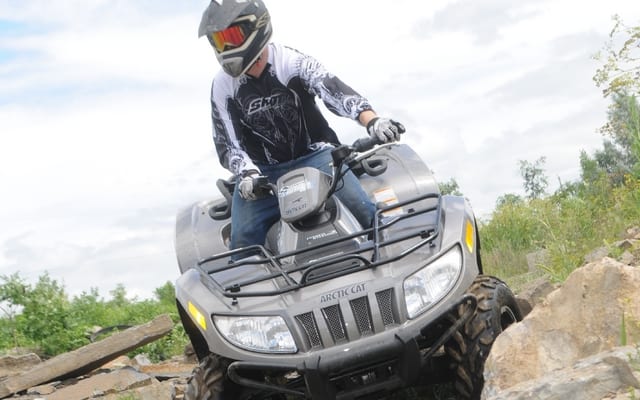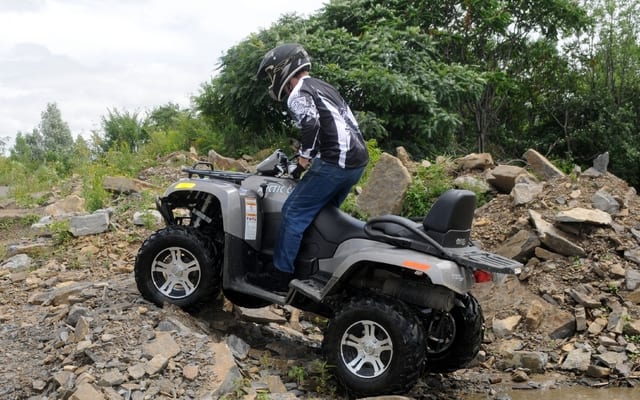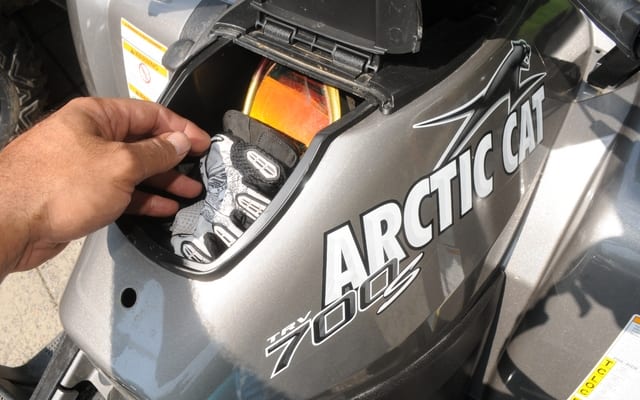This successful American snowmobile, ATV and Side x Side manufacturer is known for its extravagance in first delivering the highest powered recreational machines, in one class after another, in all of these three different segments. I first got on this particular Cat with clear intentions of treating the classy looking ride in its silver dress, like nobody else should. The rear seat removed, it only looked like an oversized single seat quad, with a hunger for some hardcore use in tough trails. So I darted into the woods, to return hours later with the usual smirk on my dirty face, that Arctic Cat rides seem to always cause.
The very first section of trail I threw myself in is a new one carved from out of a friend’s backyard to reach another that already connected to the one bringing us to our newly found, privately owned, testing grounds, at Saisons Express in Léry Québec. My companion wanted to keep the tree cutting to a minimum, so this new bit of trail is very tight and still littered with some tree stumps. It is no trail to be blasting through; yet, reaching the main trail was a surprisingly quick and easy task on this big Cat. An odd feeling of smallness to the entire front seems to make you forget you’re riding a big two-up and may even be a big bore machine for that matter. The grips are quite small, which is something Clo, our devoted lady test driver, preferred over most other rides. In general, it seems that the constructors usually do not take into consideration the possibility that smaller hands of ladies will be at the commands. The brake levers remain at the tip of her small fingers like on any other such big quad and she said she wished some of them had adjustment capability as some sport quads now have. The smaller tires up front also contribute in toning down the mega quad effect these stretched out rides normally tend to create. Only when the need arises to closely, pay attention to the rear wheels, in tougher rock crawling situations for example, you do realize you’re at the commands of a pretty large and powerful beast. In all, six new power steering models are now available, three 550 S models and three 700 S varieties.
Take it easy!
You might be interested to know that we also do quite a bit of hard testing, while riding with a passenger; figuring out many different aspects of the ride, which wouldn’t be exposed while testing it alone. How the machine handles emergency braking situations: how the passenger stays on despite some side to side yanking, or up and down motion from hitting bumps. Luckily for my companion, our guinea pig passenger on this occasion, this particular model from Arctic Cat turned out to be one of the safest to ride in true to life Two-Up trailing situations. No unwanted surprises would be a good general description of the experience felt on the back seat of this cool quad. The rear grab handles offer a myriad of different ways to hold on, which becomes crucial when navigating through tougher areas and the seat is very comfortable without too much bounce when hitting sharp bumps.
Before moving on to precise details of this fine-looking ride, let me take the time to re-iterate the fact that we push any and every machine to its very limits; so you don’t have to! I will have you notice that when you see the ride being driven in extreme climbing, descending or any other illogical predicament for a two-up on our photos, there is nobody sitting in the back. I will never say this enough; two-up riding on a quad should be for nature-loving slow treks in the woods, rather than thrill seeking high speed runs intended to scare the passenger from ever wanting to ride on a quad again.
This 2010 Arctic Cat TRV 700 S model is essentially the same as the previous 700 H1 EFI 4×4, with the addition of power steering and a few other minor changes. Among the key features included are: five-way pre-load adjustable front and rear shocks; 10 inches of suspension travel;, a whopping 11 inches of ground clearance and an all-encompassed electronic 2WD/4WD/Differential lock Switch. I absolutely loved how it made traction mode switches very quick and easy. This means, in other words, awesome conquering capability, in total comfort and ease of operation. This fine new version of the 700, with its Tungsten Metallic painted plastics, includes 12-inch machined aluminum wheels with black inlays, which we found to be sufficiently protected by the Duro tires mounted on them. Despite some aggressive efforts on our part to conquer mounds of rocks, we always enjoy trying to roll up and over. Very few traces of abuse were visible on those shiny and beautiful heavy-duty polished aluminum wheels, after our three weeks of abusive use. I particularly liked how the ride looked without the rear seat on. At a glimpse, when burning up a fast section of trail, it could almost be mistaken for the mighty Thundercat 1000, just a big quad with huge racks that manages to feel a bit sporty at times.
Arctic Cat’s Variable Assist Electric Power Steering (EPS) will reduce the torque necessary to steer the ATV. Yet, it doesn’t freely turn if you push the bar with just a finger as Outlanders do in Max mode, or all the time on the Sportsman 850 Touring EPS from Polaris. Many other EPS systems I’ve had the pleasure of testing, seem to offer too much assist. Then again, that is something very much according to personal preference. In my case, I like the workout I usually get out of riding any quad and the pain felt after were only telling of how much effort I had put out for the ride.
The new aluminum-bodied, brushless electric power assisted steering system fits very snug in the front part of the frame, which needed to be slightly modified to host it. This advanced new component, which took three years to develop, determines the appropriate output to deliver in accordance with the needs of each instant, by using different sensor readings. This new system, produced in partnership with Globe Motors, senses when more pressure is applied to the bar by the user and reacts with more assistance delivered instantly. Arctic Cat engineers claim their system to be much more rapid in execution than the competitions. A sole wheel hits a big rock, the quick acceleration will be detected and the system will slow down the shaft so that bump steer is almost non-existent. It will adjust itself constantly according to the rider’s style and/or behavior changes.
I thoroughly enjoyed how the system seamlessly blended into the usual feeling of riding a quad, with a very logical dose of assist, which left a lot of room for crucial feedback and didn’t obviously stand out. In a work environment, it could have used a bit more assist at times, like the Max mode on Can-Am’s Outlander Max rides or the ultra light steering feel of a Polaris Sportsman Touring. Thing is, this quad I think has one of the safest and logically set packages for riding two-up. The toe on this EPS-equipped machine was moved out 1/8-inch on either side to provide better handling. This is something that couldn’t be done on non EPS models because it would make steering harder.
The Power to scratch.
Of course, this is no ride to be pushing into power slides or launched off a ramp. You may try to force the back end to unhook, but you might look ridiculous as you try to do so. The body transfers needed might look awkward. It is very tough to push the rear end out, and that is a great trait for such a ride. Jumping it would, of course, simply be stupid and dangerous, but I managed to catch a little air anyway to get a feel of how the suspension dealt with such abuse. No problem there, the huge amount of travel meant it was impossible to bottom out. When carving through tighter trails, all alone, it kept that sporty Cat feel, despite the elongated chassis. An aggressive press of the thumb will launch you forward smoothly, to then push forward, oh so quickly, without the possibility of lifting the front in the air. Again, this demeanor is preferable over the ground destroying power delivery of the big Outlanders from Can-Am or the Polaris Sportsman 850 Touring EPS, which could still climb up into a wheelie, if you are not careful when climbing a hill, despite the longer wheelbase.
By the way, remember to let your passenger off, if that incline exceeds 15 degrees. Arctic Cat also has its own extravagant version of a two-up in the TRV 1000 Cruiser. This 2010 Arctic Cat TRV 700 S is obviously a more logical choice, if all you do with the quad is ride two-up. The Arctic Cat built 695cc Hemi engine is a SOHC, 4-valve, 4 stroke providing a nicely spread out power band more than sufficient for any possible off-road need. It purred quietly at idle, and let out a smooth growl when more grunt was needed. For the safe negotiation of curves, they couldn’t have done a better job. The generous feel of under steer, partly created by the tad smaller tires in front, the elongated chassis and lack of grip of the dusty surfaces we were riding on, prompted me to ask my Partner Chris to get off for me to test out a theory. So, I gunned the massive 724 lbs machine and yanked the steering to one side and the other like a madman. Thing is, I had already gotten a good enough sense of how little effect this kind of aggressive gesture had on the ride when on the gas. Chris had a troubled look on his face when he asked: “What in God’s name are you doing?” See how it keeps going in a perfect straight line when I do that. That’s perfect! For a two-up anyway. It meant a great deal of time to act or react as the turning grip came in ever so gradually, in an extremely predictable fashion. I would have hated this sort of handling on most other rides, but for this two-up configuration, it was close to perfection!
The amazingly high ground clearance made it extremely able to conquer tough obstacles like big rocks, or logs. On one occasion, we came across a pretty big fallen tree on the trail, and I instinctively followed my friend who had just very simply rolled over it with the Cat two-up. The Polaris 550 X2 under me at the time, just hung atop that very same log. A good swing of my imposing body weight sufficed to convince it into crossing over, but it was much more of a struggle, despite the fact that I had the tad bigger 26 inch tires. It was almost totally impervious to our attempts at drowning it in water and mud. Only a burnt fuse for the fan needed replacement at some point and I liked that the quad itself sort of pointed out the problem by switching into a limited rev mode and flashing a temperature warning on display. The spare fuses were right there in the fuse box cover and the fan came back to life to cool things off again.
Deep mud isn’t where this classy ride seemed to truly belong, but it did get us through most dirty holes we threw it in. Getting out of gutters took quite a bit of convincing with weight transfers. The advantages that the bit of under steer provided us with, such as a very good amount of feedback despite the steering assist, were now working against us a little, as the ride many times pushed forward in a straight line while the tires up front fought hard to find grip and turn. To have to add a little convincing with a weight transfer to the front, was a small price to pay for having a two-up almost impossible to tip over in most normal riding conditions. The fact that the 4WD mode with front diff-lock was quickly engaged, with one simple upward slide of the thumb, was immensely practical in those more challenging and slippery trail sections. Back on dryer and flatter grounds, I propped a side up and rode on just two wheels as I frequently do to figure out a few things: first and foremost, how hard it is to get it up into that precarious position and this also gives me a very good sense of how well the front suspension is bias with the rear. The TRV was extra hard to get two side wheels off the ground, and that is exactly what I was hoping for from this really comfortable and easy to use trail cruiser for two.
The problem with lots of comfort and ease of operation, is that it takes away some of the scare effect of higher speeds, which can many times be a life saver. At least this ride’s demeanor was very predictable, but I still feel that I need to encourage a much more conscientious approach to riding, when using any such powerful stretched out quad. No need to say that if someone is sitting in the back, this will prompt at least twice as much caution and much lower operating speeds.
At work, is where the new power steering system’s presence becomes obvious and most valuable. Repeated needs for quick turnarounds won’t add any effort to a day filled with tough chores and the standard two-inch receiver and 300 pounds of front/rear rack capacity, mean you can really put this big Cat to good use in between relaxing rides with your tender other half. The fully digital gauge displays up to 14 critical operation information indicators including: clock/hour-meter, fuel level, mode button, set/reset button, odometer/ trip meter, gear position, speedometer/tachometer, needle display, differential lock, drive select, high beam, battery condition, temperature and oil pressure. It stayed perfectly visible in bright daylight or in the dark of night. It would be really cool if the whole display would be a little bigger. There is a lot of extra room around it in that rounded plastic box on the top and center of the handlebar. As a matter of fact, there isn’t much more improvements to suggest on this very nicely done touring quad. It would be nice if they find a way to fix the lack of room for your right foot which stays sort of stuck under the rear brake pedal all the time.
Also very practical was the decently sized glove box, front center and high on the quad, where water and mud hardly ever reach. Its cover is more easily and quickly opened than those big gas cap resembling reservoirs, many Japanese rides have nowadays. It can hold quite a bit of trinkets, other than tools, as that aspect is very intelligently taken care of with an under the seat rack system that holds down every tool and keeps everything in order at all times.
Perfectly adapted, when the operator is
If you are looking for a dependable machine for long treks out far and exploring nature every weekend, I foresee that the 2010 Arctic Cat TRV 700 S will provide comfort and peace of mind for many years to come, as long as you take decent care of it and follow the maintenance schedule. The handling on this quad is actually the best and safest feeling I’ve tried so far out of all those North American rides that are purposely built to carry a passenger. It brakes fine, but a little more precise control over wheel locking would be appreciable, but that’s true about all Two-up quads. Be mindful that they all have engine braking, which is great in most normal riding situations, but becomes a little trickier as one climbs over the 50 km/h mark and/or far beyond that. Your wheels can stay locked up for a good second after release of the brake (sometimes much more), as the engine brake then prevents the wheels from rolling back up to speed quickly enough. Japanese brands seem to all have a better handle on that aspect of precision braking, both with better controls and lesser time for the wheels to roll again. Main rule of thumb is simply to ride safe and get to know your machine well, before you invite a dear one to hop on. Go on, have fun!
For more information on the above mentioned models, please visit the Arctic Cat Website
More from Arctic Cat on ATV Trail Rider :
Arctic Cat ATV Models – Arctic Cat UTV Models – Arctic Cat ATV Reviews – Arctic Cat UTV Reviews








